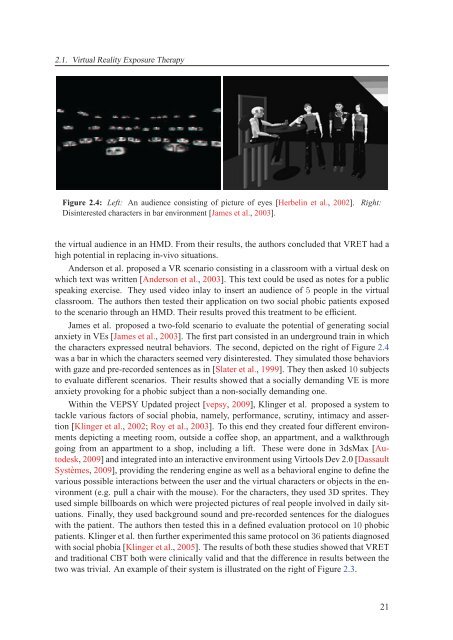Texte intégral / Full text (pdf, 20 MiB) - Infoscience - EPFL
Texte intégral / Full text (pdf, 20 MiB) - Infoscience - EPFL
Texte intégral / Full text (pdf, 20 MiB) - Infoscience - EPFL
Create successful ePaper yourself
Turn your PDF publications into a flip-book with our unique Google optimized e-Paper software.
2.1. Virtual Reality Exposure Therapy<br />
Figure 2.4: Left: An audience consisting of picture of eyes [Herbelin et al., <strong>20</strong>02]. Right:<br />
Disinterested characters in bar environment [James et al., <strong>20</strong>03].<br />
the virtual audience in an HMD. From their results, the authors concluded that VRET had a<br />
high potential in replacing in-vivo situations.<br />
Anderson et al. proposed a VR scenario consisting in a classroom with a virtual desk on<br />
which <strong>text</strong> was written [Anderson et al., <strong>20</strong>03]. This <strong>text</strong> could be used as notes for a public<br />
speaking exercise. They used video inlay to insert an audience of 5 people in the virtual<br />
classroom. The authors then tested their application on two social phobic patients exposed<br />
to the scenario through an HMD. Their results proved this treatment to be efficient.<br />
James et al. proposed a two-fold scenario to evaluate the potential of generating social<br />
anxiety in VEs [James et al., <strong>20</strong>03]. The first part consisted in an underground train in which<br />
the characters expressed neutral behaviors. The second, depicted on the right of Figure 2.4<br />
was a bar in which the characters seemed very disinterested. They simulated those behaviors<br />
with gaze and pre-recorded sentences as in [Slater et al., 1999]. They then asked 10 subjects<br />
to evaluate different scenarios. Their results showed that a socially demanding VE is more<br />
anxiety provoking for a phobic subject than a non-socially demanding one.<br />
Within the VEPSY Updated project [vepsy, <strong>20</strong>09], Klinger et al. proposed a system to<br />
tackle various factors of social phobia, namely, performance, scrutiny, intimacy and assertion<br />
[Klinger et al., <strong>20</strong>02; Roy et al., <strong>20</strong>03]. To this end they created four different environments<br />
depicting a meeting room, outside a coffee shop, an appartment, and a walkthrough<br />
going from an appartment to a shop, including a lift. These were done in 3dsMax [Autodesk,<br />
<strong>20</strong>09] and integrated into an interactive environment using Virtools Dev 2.0 [Dassault<br />
Systèmes, <strong>20</strong>09], providing the rendering engine as well as a behavioral engine to define the<br />
various possible interactions between the user and the virtual characters or objects in the environment<br />
(e.g. pull a chair with the mouse). For the characters, they used 3D sprites. They<br />
used simple billboards on which were projected pictures of real people involved in daily situations.<br />
Finally, they used background sound and pre-recorded sentences for the dialogues<br />
with the patient. The authors then tested this in a defined evaluation protocol on 10 phobic<br />
patients. Klinger et al. then further experimented this same protocol on 36 patients diagnosed<br />
with social phobia [Klinger et al., <strong>20</strong>05]. The results of both these studies showed that VRET<br />
and traditional CBT both were clinically valid and that the difference in results between the<br />
two was trivial. An example of their system is illustrated on the right of Figure 2.3.<br />
21

















